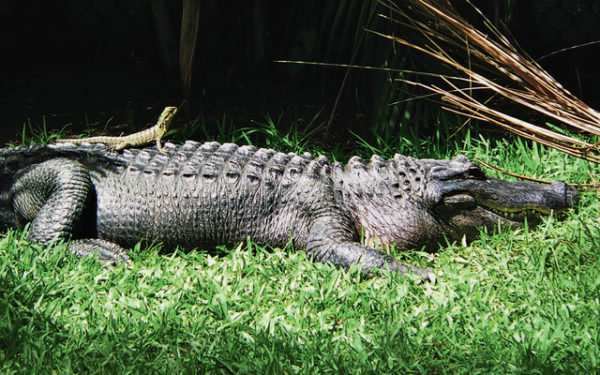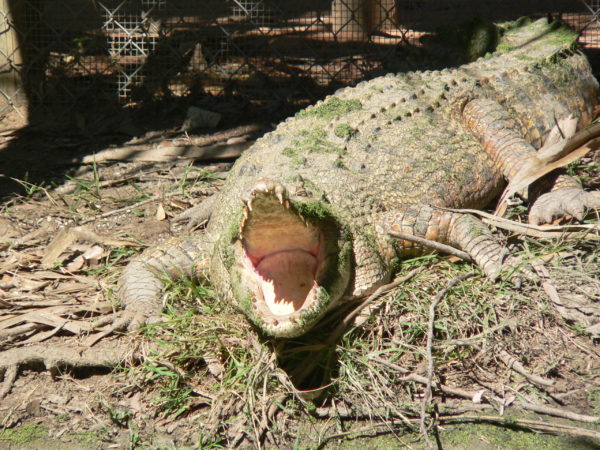Published in the Ocean Watch column, Honolulu Star-Advertiser © Susan Scott
October 15, 2016
TOWNSVILLE, AUSTRALIA >> We arrived in the Townsville marina to find a notice from the Queensland government. On the gate of Honu’s pier, a sign read, “WARNING! ACHTUNG! Recent crocodile sighting in this area. Crocodile attack can cause serious injury or death. Keep out of the water and well away from the water’s edge.”
Craig’s reaction: “Why write ‘attention’ in German?” I wondered what triggered the notice since crocodiles are native to the area, and the sign wasn’t here when we left. As it happens, a 15-foot-long crocodile was sighted about 150 feet off the city’s popular beach and walkway called The Strand. Because crocodiles have been a protected species in Australia since the 1970s, if a croc is over 6 feet long and in a high-use area, rangers don’t kill the animal, but rather relocate it.
 A crocodile gives a hitchhiker a ride at the Australia Zoo.
A crocodile gives a hitchhiker a ride at the Australia Zoo.
©2016 Susan Scott
State rangers were called to catch the Townsville salty, so called because although crocodiles usually live in rivers and estuaries, they swim from one to another via the ocean. And sometimes, if the fishing is good, a croc will stick around a particular island. We once anchored off Hope Island, where a large sign said, “Crocodiles inhabit this area. Do not enter the water.”
We skipped snorkeling. People here call Australia’s second croc species “freshies,” but this and “salties” are misleading names. Both can live in either fresh or salt water. They go where the food is.
Males are larger than females, reaching about 20 feet long and weighing over a ton. Females grow to about 9 feet. The male off Townsville — estimated to be age 50 — had lived a hard life fighting other males for territory. He had lost an eye and all but a few teeth.
 Saltwater Crocodile.
Saltwater Crocodile.
Courtesy Scott R. Davis
But the geriatric titan got a break. After a period of rest to get over the stress of capture, the grand old croc went to a zoo or farm to live the rest of his days in peace.
The day after our Townsville arrival, a friendly local sailor showed us the best anchoring sites off Townsville’s nearby islands.
“Here’s a lovely reef,” she said, pointing at the chart. “And here, and here.”
“Is it safe to swim there?” Craig asked.
“People swim there all the time,” she said.
“What about the crocodile warnings?”
“Oh, we just keep an eye out while we’re in the water,” she replied. Such tolerance for an apex predator is the result of Queensland’s “Croc Wise Education Campaign,” developed to inform the public about the value of crocodiles and how to live with them. It’s working. In discussions of crocs here, “No worries” is the general attitude. So, OK. We’ll go snorkeling, pay attention, and if we see a salty we’ll call out, “Achtung!”